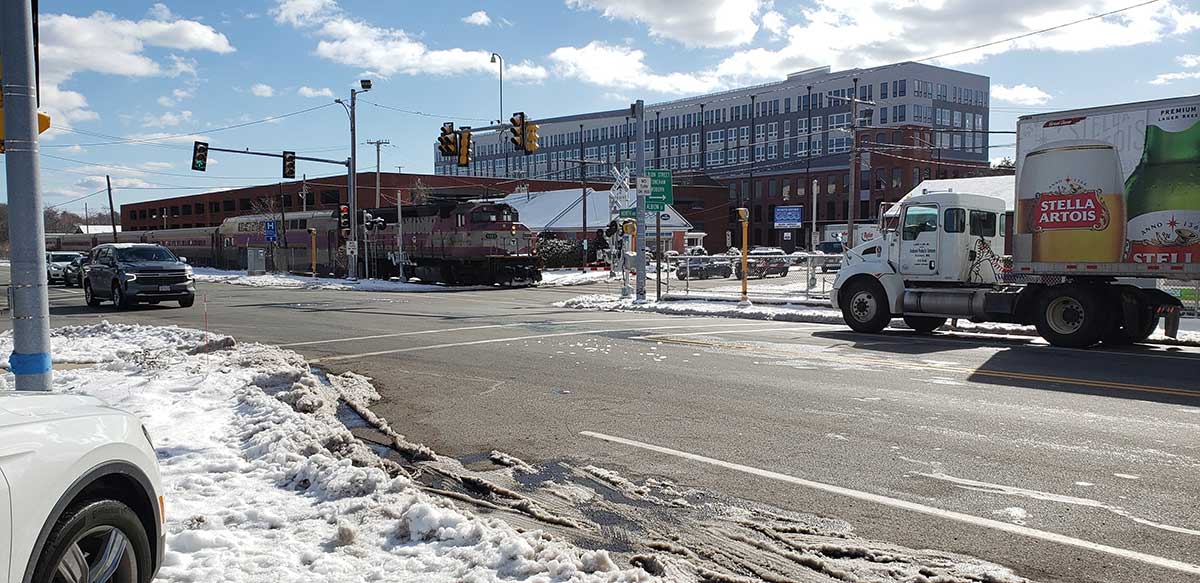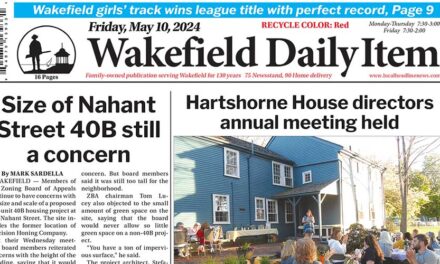By MARK SARDELLA
WAKEFIELD — Residents continue to voice strong opposition to the local plan that has been developed to comply with the state’s MBTA communities multifamily zoning mandate.
At last week’s final public hearing on the local compliance model, most speakers opposed the plan, mirroring the feedback at previous hearings and forums held by the Planning Board. Residents objected to a model that goes well beyond the state requirement, allowing more multifamily housing over a greater geographic area than mandated by the state.
Last week’s hearing began with another review of the relevant statute and the town’s compliance model that was developed by a Working Group under the auspices of the Planning Board.
In 2020, the Massachusetts Zoning Act (Section 3A of Massachusetts General Laws Chapter 40A) was amended to promote the production of multi-family housing within walking distance of public transportation to address a “severe regional housing shortage.”
The new Zoning Act requires all MBTA communities, including Wakefield, to create at least one multi-family zoning district of reasonable size near public transit in which multi-family housing is permitted as of right. “As of right” means that a developer may proceed without obtaining a Special Permit, variance, zoning amendment, waiver, or other zoning approval. In the proposed district, the plan would allow up to four units in a three-story building with a height of up to 35 feet on a minimum lot size of 4,000 square feet.
Towns that don’t comply with the state mandate face penalties including loss of state grant opportunities.

RESIDENTS continued to speak against the town’s plan to comply with the state’s MBTA multifamily zoning mandate at last week’s Planning Board hearing. (Frank Conte Photo)
The first resident to speak at last week’s Planning Board hearing was Nancy Bertrand of Shumway Circle.
Bertrand, who has long chaired the Wakefield Historical Commission, said that because the proposed multifamily zone centers around the downtown, it places historic properties at special risk.
“You are putting out a welcome mat for developers to swoop in and pull down historic homes and buildings,” she said. “Why are we developing a plan that will guarantee the destruction of the character of our town?”
Bertrand said she favored doing the minimum to comply with the state mandate.
Donald Dusenberry of Parker Road said that he could not understand why streets with large developments like Foundry Street and North Avenue were not included, suggesting that they are “exactly what the state is calling for.” He maintained that including those streets would alleviate development in other areas of town.
Dawn Millward of Emerald Street focused on the parking issue, disputing the premise that plan will reduce the number of cars.
“If you add units, realistically, people will still have cars,” she said.
Ted Gaffney of Morrison Road West said that he agreed with the points made by Bertrand and Dusenberry. He said that despite all the new apartment buildings in town, he has not seen an increase in foot traffic. He also noted that commuter rail ridership is way down. He also called for doing the minimum to comply with the state mandate.
Rick Stewart of Salem Street pointed out that the proposed compliance plan does nothing to increase affordable housing and would strain the town’s infrastructure. He warned that the new housing will result in more kids in the schools and more traffic on the roads.
Bronwyn Della-Volpe was critical of the planning Board and its Working Group for not listening to those who favored a minimal compliance district.
“It’s a slap in the face to every resident of this town,” she said, “that this board did not listen and take into consideration what people have been saying about this plan.”
Eleanor Axelrod observed that the compliance plan put forth does not address affordability. All the resulting housing will be market rate, she noted. She added that other towns took different approaches and incorporated changes based on public feedback.
Town Councilor Michael McLane, who lives on Fairmount Avenue, noted that there are many single-family homes in the proposed district that could be lost, resulting in lower amounts of reasonably priced housing stock in town.
“You are understating the growth that could occur under this plan,” McLane said. “We should do the minimum district. You are doing a disservice to the town by going with this larger district.”
Eric Wages of Warren Street was more sympathetic to the proposed plan, suggesting that increasing enforcement related to traffic and parking might placate some of the opponents’ concerns.
Scot McCauley of Walden Road noted that Milton had rejected the state mandate entirely and suggested that Wakefield could do the same. He insisted that the cost of the infrastructure needed to support all of this new housing would dwarf any loss of grant money as a result of not complying.
He noted that nobody takes the train anymore, undercutting the entire premise of the mandate. He also observed that few people walk or bike, except in the summer.
McCauley urged everyone to attend the Town Meeting and vote the plan down.
“This is going to destroy the town,” he insisted. “This will not drive prices down. It will drive prices up.”
Dennis Cloherty of Harvest Road favored the plan developed by the Working Group, calling it “a good plan.” He maintained that more people would use bicycles if the infrastructure was present.
Attorney Brian McGrail of Outlook Road cautioned against outright noncompliance with the state mandate. He warned that the Attorney General has threatened civil action against communities that do not comply.
But another speaker pointed out that most people are not calling for outright non-compliance. They are calling for a smaller district that meets the state mandate but does not go beyond it.
Planning Board members agreed to wait until their March 26 meeting to vote on whether they will support the proposed compliance model at Town Meeting on April 29.
For the first time, they also mentioned developing a smaller compliance model as an alternative, should their expanded plan fail at Town Meeting. But they may have been beaten to the punch, as Town Councilor Edward Dombroski delivered a citizen petition to the Town Clerk last Friday for a minimum compliance Town Meeting article.




